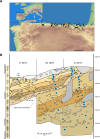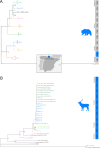A sedimentary ancient DNA perspective on human and carnivore persistence through the Late Pleistocene in El Mirón Cave, Spain
- PMID: 39747910
- PMCID: PMC11696082
- DOI: 10.1038/s41467-024-55740-7
A sedimentary ancient DNA perspective on human and carnivore persistence through the Late Pleistocene in El Mirón Cave, Spain
Erratum in
-
Author Correction: A sedimentary ancient DNA perspective on human and carnivore persistence through the Late Pleistocene in El Mirón Cave, Spain.Nat Commun. 2025 Jan 17;16(1):779. doi: 10.1038/s41467-025-56198-x. Nat Commun. 2025. PMID: 39824823 Free PMC article. No abstract available.
Abstract
Caves are primary sites for studying human and animal subsistence patterns and genetic ancestry throughout the Palaeolithic. Iberia served as a critical human and animal refugium in Europe during the Last Glacial Maximum (LGM), 26.5 to 19 thousand years before the present (cal kya). Therefore, it is a key location for understanding human and animal population dynamics during this event. We recover and analyse sedimentary ancient DNA (sedaDNA) data from the lower archaeological stratigraphic sequence of El Mirón Cave (Cantabria, Spain), encompassing the (1) Late Mousterian period, associated with Neanderthals, and (2) the Gravettian (c. 31.5 cal kya), Solutrean (c. 24.5-22 cal kya), and Initial Magdalenian (d. 21-20.5 cal kya) periods, associated with anatomically modern humans. We identify 28 animal taxa including humans. Fifteen of these taxa had not been identified from the archaeozoological (i.e., faunal) record, including the presence of hyenas in the Magdalenian. Additionally, we provide phylogenetic analyses on 70 sedaDNA mtDNA genomes of fauna including the densest Iberian Pleistocene sampling of C. lupus. Finally, we recover three human mtDNA sequences from the Solutrean levels. These sequences, along with published data, suggest mtDNA haplogroup continuity in Iberia throughout the Solutrean/Last Glacial Maximum period.
© 2024. The Author(s).
Conflict of interest statement
Competing interests: The authors declare no competing interests.
Figures






Similar articles
-
Pleistocene sediment DNA reveals hominin and faunal turnovers at Denisova Cave.Nature. 2021 Jul;595(7867):399-403. doi: 10.1038/s41586-021-03675-0. Epub 2021 Jun 23. Nature. 2021. PMID: 34163072 Free PMC article.
-
Pleistocene chronology and history of hominins and fauna at Denisova Cave.Nat Commun. 2025 May 21;16(1):4738. doi: 10.1038/s41467-025-60140-6. Nat Commun. 2025. PMID: 40399313 Free PMC article.
-
Revisiting the Middle and Upper Palaeolithic archaeology of Gruta do Caldeirão (Tomar, Portugal).PLoS One. 2021 Oct 27;16(10):e0259089. doi: 10.1371/journal.pone.0259089. eCollection 2021. PLoS One. 2021. PMID: 34705887 Free PMC article.
-
Pre-Solutrean rock art in southernmost Europe: Evidence from Las Ventanas Cave (Andalusia, Spain).PLoS One. 2018 Oct 17;13(10):e0204651. doi: 10.1371/journal.pone.0204651. eCollection 2018. PLoS One. 2018. PMID: 30332432 Free PMC article.
-
Archaic human genomics.Am J Phys Anthropol. 2012;149 Suppl 55:24-39. doi: 10.1002/ajpa.22159. Epub 2012 Nov 2. Am J Phys Anthropol. 2012. PMID: 23124308 Review.
References
-
- Jones, E. L. & Carvalho, M. Ecospaces of the Middle to Upper Paleolithic transition: The archaeofaunal record of the Iberian Peninsula. J. Hum. Evol.177, 103331 (2023). - PubMed
-
- Lindly, J. Hominid and carnivore activity at Middle and Upper Paleolithic cave sites in eastern Spain. Munibe Antropologia Arkeologia40, 45–70 (1988).
-
- Rosell, J., Baquedano, E., Blasco, R. & Camarós, E. New insights on hominid-carnivore interactions during the Pleistocene. J. Taphon.10, 125–128 (2012).
-
- Pinto-Llona, A. C., Estaca, V., Grandal-d’Anglade, A., Romero, A. J. & Yravedra, J. Alternation between humans and carnivores in the occupations of the Mousterian site of Sopeña rock-shelter (Asturias, Spain). Quat. Sci. Rev.328, 108468 (2024).
Publication types
MeSH terms
Substances
LinkOut - more resources
Full Text Sources

